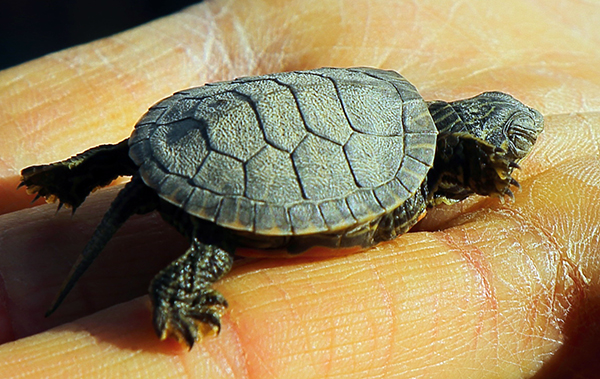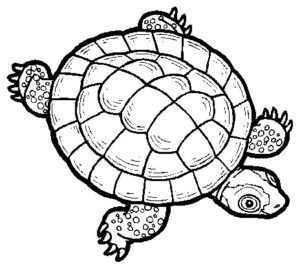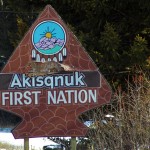Home »

Celebrating Cranbrook’s most ancient creatures
By Dan Hicks
Hello sunny surface world – here I come!
Eyes closed prior to its release, a western painted turtle hatchling (Chrysemys picta bellii) crawls forward on the hand of a Rocky Mountain Naturalist on Turtle Day at Cranbrook’s Elizabeth Lake on May 2.
A survivor of epidemic skunk predation while hibernating beneath the lakeshore, this determined little turtle was one of a meagre remnant population of only five hatchlings released into the lake that day.
The primary bone plates composing its top shell are prominent (they total 13) and its foot webbing is also visible. The painting below shows the anterior of its bottom shell colour splotch.
 Originating 220 million years ago in the Triassic age on the supercontinent of Pangaea, turtles belong to the Testudinata order; our oldest extant reptiles, they merrily mingled with the earliest of the mighty dinosaurs.
Originating 220 million years ago in the Triassic age on the supercontinent of Pangaea, turtles belong to the Testudinata order; our oldest extant reptiles, they merrily mingled with the earliest of the mighty dinosaurs.
Western painted turtles themselves date back 15 million years; we humans are the brash new kids on the block and, in more recent times, have hardly been the nicest of neighbours. The Committee on the Status of Endangered Wildlife in Canada (COSEWIC) lists western painted turtles in British Columbia’s southern interior as being of “Special Concern” due to the elimination and fragmentation of their precious wetland habitat homes.
The Rocky Mountain Naturalists (RMN) have created favourable shoreline nesting habitat for turtle eggs and monitored both nests and turtles at Elizabeth Lake since 1992 and, since 2014, their Turtle Day activities outside Elizabeth Lake’s Visitor Centre have facilitated learning by school children and the general public about the life cycle of these shell-encased riparian creatures which can live upwards of 50 years (but only with a whole lotta luck).
A reoccurrence of the Visitor Centre parking lot traffic crunch was prevented this year by public utilization of the parking lot adjacent to Elizabeth Lake Lodge. The low number of hatchlings necessitated the use of a sandbox to illustrate turtle nesting behaviour but afterward, via manual bucketing, Naturalists deposited the sand onto a favoured nesting shoreline. FM107 publicized Turtle Day on-air, and a station staffer attended and interviewed principal RMN turtle nurturer – Greg Ross.

Cranbrook hosted two intriguing wildlife symposiums this April; the Kootenay Wildlife Heritage Fund Society held a Big Game Symposium and, through it shunned the former, our provincial government held a Public Consultation Meeting on its Southern Mountain Caribou Preservation Plans. Neither assembly tackled turtle issues, yet the proffered higher order predator-prey dynamics were evocative of our local turtle-skunk dynamic – itself no simple duality.
Should our turtles continue to be devoured as midnight mephitine hors d’oeuvre, their possible extirpation would not, unfortunately, result in their extirpators also plunging in number; omnivorous and resourceful, our local skunks would easily adapt to an array of alternative items available in their town and country cuisine, all the while continuing to maximize their portly population.
Were Elizabeth Lake’s western painted turtle hatchlings graced with an ounce of the public ardor heaped upon a remote Royal baby, we nature-minded commoners could rest assured that our remaining natural riparian landscapes would indeed be preserved – not only for the benefit of our own sapien successors, but also for our chromatic swamp babies – rare, ancient, nameless – and forever untitled.
My surface world seems to fall off right here!
 The same western painted turtle hatchling pauses to ponder the precipice it has encountered, calmed by the knowledge that, ultimately, our entire universe balances on the shell of its cosmic cousin, which in turn stands astride an even larger turtle and so on, so that collectively, they constitute an infinite turtle column; and age-old testudinate wisdom tells us all that, as ever – it’s turtles all the way down.
The same western painted turtle hatchling pauses to ponder the precipice it has encountered, calmed by the knowledge that, ultimately, our entire universe balances on the shell of its cosmic cousin, which in turn stands astride an even larger turtle and so on, so that collectively, they constitute an infinite turtle column; and age-old testudinate wisdom tells us all that, as ever – it’s turtles all the way down.
Appreciative of such foundational support, my sympathies are solidly behind imperiled Team Turtle, and not at all with their voracious Elizabeth Lake predators, regardless of how convincing those cynics among us may be that our natural kinship allegiance lies with Team Skunk; though God forbid, falling into our frightful new Anthropocene age, our future might hold little more than heat, drought, dust, and a plethora of polecats.
Lead image: RMN turtle hatchling handler – Katrin Powell. Photos by Dan Hicks







